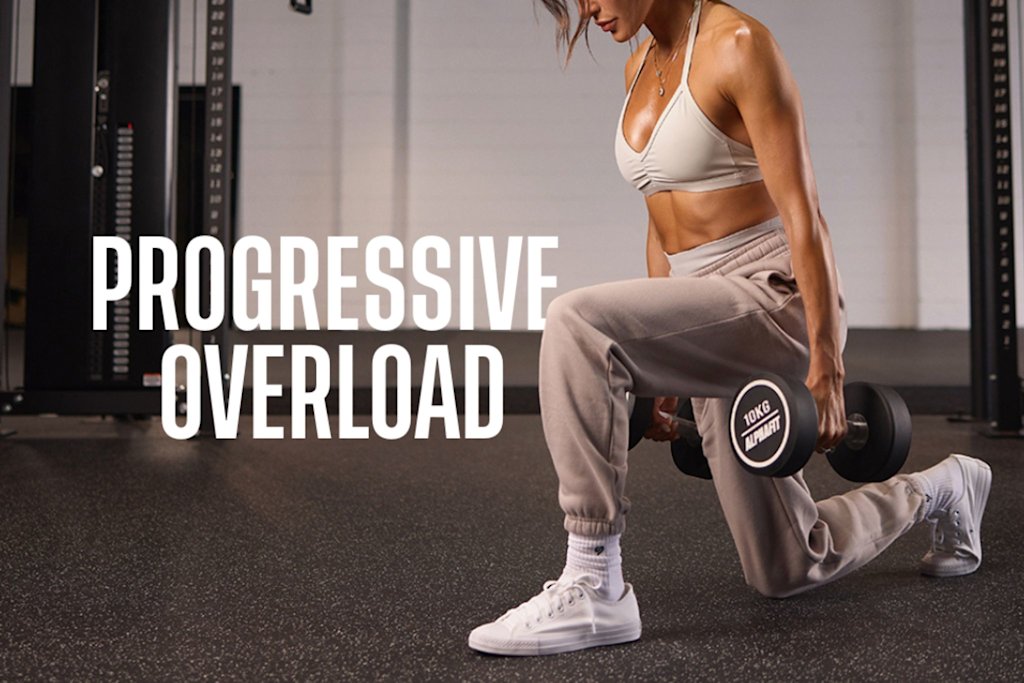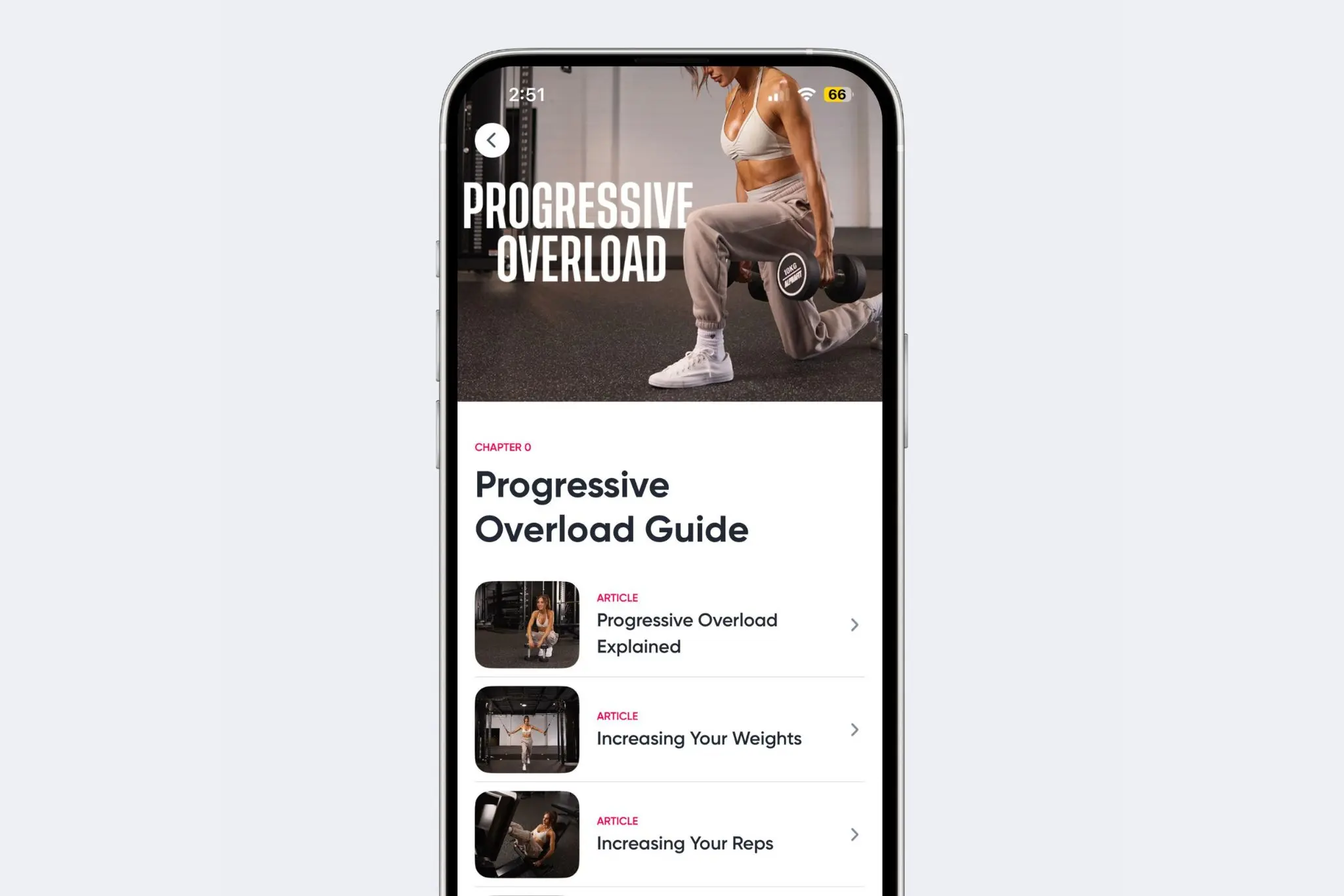Why Progressive Overload Is A MUST For Results
So, you want to see results with your strength training? Progressive overload training is going to be your new best friend.

February 5, 2021 - Updated October 17, 2025

Rome wasn’t built in a day, and neither are you. Building muscle and making progress with your strength training routine takes time and patience, but there’s a big difference between doing a bunch of workouts simply hoping for the best and actually following a program and training principles for specific results.
This is where progressive overload training comes in. It’s an absolute essential if you want to achieve muscle growth and see improvements in your strength while avoiding injuries, burnout and workout plateaus.
They say nothing worth having comes easy, but understanding progressive overload doesn't need to be hard!
What is progressive overload training?
Essentially, you need to gradually challenge your body over time if you want to get stronger or fitter. By continuously pushing your body to do just a little bit more than it’s used to, you force it to adapt and get stronger, fitter or faster.
The obvious way to make strength and muscle gains is to lift heavier weights, but there are several other ways to increase the level of stress on your muscles. Progressive overload can be achieved by adjusting four elements of your workouts (and there's a helpful guide on this in the Sweat app!):
Volume: more reps and/or sets
Intensity: heavier weights
Density: shorter rest periods or faster tempo
Frequency: more workouts
Slowly and strategically increasing the stress on your body triggers its natural, adaptive responses, leading to increases in strength and performance, aka gains.
While progressive overload can also apply to any training style, generally we use the term when we’re talking about strength training with programs like Strength with Kayla, Strength At Home, or Strength & Sculpt..

Intensity: Gradually increase your weights
If you want to lift heavier, at some point you need to try lifting heavier - even if it’s only by a small amount. Lifting heavier weights puts your muscles under more stress, causing microtears that will repair and rebuild, leaving the muscle stronger. Little by little, what was once hard will start to feel easy, and you’ll be ready to add even more weight.
When should you increase your weights?
If you get to your final few reps and think that you could definitely keep going for several more reps, you’re ready to lift heavier.
You should aim to increase your weights slightly every 2-3 weeks if you’re pushing yourself with your training, but this pace might be faster if you’re a beginner, and slower if you’re already lifting heavy.
How much weight should you increase by?
This depends on how light or heavy your weights were to begin with! Your new weight should make it feel hard to finish your final reps while still maintaining good form.
If you started way too light for your strength level, this might mean going from 2kg dumbbells to 10kg dumbbells. If your starting weight was pretty good, you might only be making a small increase, such as going from 10kg dumbbells to 12kg dumbbells.
It’s normal to find that you’re able to increase more on lower body exercises (like squats, deadlifts and hip thrusts) than upper body exercises (like bench press or bicep curls).
Grabbed heavier weights and can feel your form isn’t so good anymore? Go lighter. Form is always more important than weight. It’s easy to track your progression by recording the weights you have lifted in the Sweat app, and some workouts even offer RPE guidance (rate of perceived exertion) to help you figure out how much weight you should be lifting.
Volume: More reps, more sets
This is a great way to fatigue your muscles if you don’t have access to heavier weights. If 12 reps is starting to feel easy on your back squats, but you don’t have heavier weights available (or don’t feel ready to lift heavier), you can challenge your body further by going for 15 reps instead or add another set.
Completing more reps still increases your overall training volume, forcing your body to adapt.
To be clear, we’re not recommending you do 40 reps of squats to get more out of your session; it’s simply about aiming for the higher end of a rep range. Instead of doing 8 reps, you might go for 12. Or instead of 12 reps, you might try 15.
If you’re already at the high end of the rep range, you can also increase the time of your reps for even more time under tension to fatigue the muscle. Slow down on the lower phase of the movement and push with power on the lift phase.
Density: Cut down the rest or pick up the pace
Unless you’re doing heavy lifting and require longer rest periods between sets to let your muscles properly recover, reducing your rest periods is another way you can unlock a new level of difficulty in your workout.
Shorter rest periods can help to increase muscle endurance and metabolic stress - good for muscle pump and hypertrophy. Reducing your rest periods can also make a moderate weight feel much harder if you don’t have heavier weights available.
If you’re used to resting for two minutes between sets, see what difference it makes to reduce it to 60-90 seconds. If a 60-second rest is more your vibe, try a 30-second rest to spice things up.
Frequency: Add in another workout
Finally, you can challenge your body to grow and adapt by completing more workouts each week.
If you’re already training 3-5 times a week, this might not be a relevant goal for you (we’re not recommending you try to do as many workouts as possible - your rest days are essential!), but it’s a great goal to focus on if you’re only strength training 1-2 times a week.
Working out more frequently increases your total training volume, which helps muscles grow and adapt faster, without necessarily lifting heavier every session.
Workout frequency is a personal thing and really depends on your lifestyle, schedule and muscle group split. You might prefer three full-body workouts with rest days in between, or four workouts with specific muscle group focuses.
Challenge equals change!
Progressive overload sounds a lot more complicated than it really is. What it ultimately boils down to is continually challenging your muscles beyond what they’re comfortable with. By doing this consistently, you’ll set yourself up to see progress, build strength and smash your goals.
It’s important to remember that while progressive overload involves four elements — volume, intensity, density and frequency — you absolutely don’t need to increase all of these at once in every workout.
Log your progress in the Sweat app, work hard and remember you’re in this for the long game. The results will come!

A more empowered you starts with Sweat, and our editorial team is here to bring you the latest fitness tips, trainer recommendations, wellbeing news, nutritional advice, nourishing recipes and free workouts.
* Disclaimer: This blog post is not intended to replace the advice of a medical professional. The above information should not be used to diagnose, treat, or prevent any disease or medical condition. Please consult your doctor before making any changes to your diet, sleep methods, daily activity, or fitness routine. Sweat assumes no responsibility for any personal injury or damage sustained by any recommendations, opinions, or advice given in this article.
Fitness